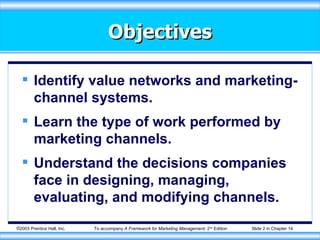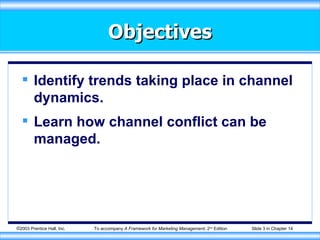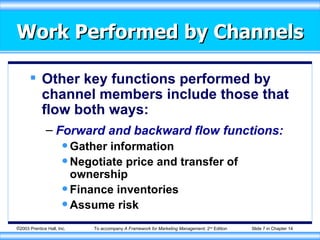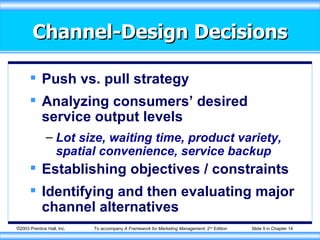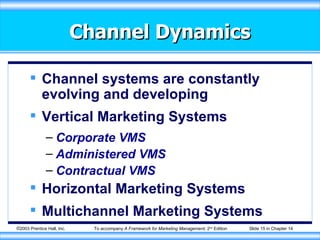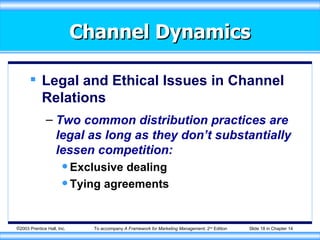Designing and Managing Value Networks and Marketing Channels
- 1. Chapter 14 Designing and Managing Value Networks and Marketing Channels PowerPoint by Karen E. James Louisiana State University - Shreveport
- 2. Objectives Identify value networks and marketing-channel systems. Learn the type of work performed by marketing channels. Understand the decisions companies face in designing, managing, evaluating, and modifying channels.
- 3. Objectives Identify trends taking place in channel dynamics. Learn how channel conflict can be managed.
- 4. Value Networks and Marketing Channel Systems A Value Network is a system of partnerships and alliances used by a firm to source, augment, and deliver its product or service offerings. Intermediaries that help get the product from manufacturer to consumer or end users form the Marketing Channel(s) .
- 5. Work Performed by Channels Producers establish marketing channels for a variety of reasons: Producers lack financial resources necessary for direct marketing Direct marketing is not feasible for many offerings Using channels frees money for investment in main business Intermediaries are more efficient
- 6. Work Performed by Channels Channel members perform a number of key functions: Forward flow functions: Develop / disseminate communication Store and move the physical products Oversee transfer of ownership Backward flow functions: Place orders with manufacturers Facilitate payment of bills
- 7. Work Performed by Channels Other key functions performed by channel members include those that flow both ways: Forward and backward flow functions: Gather information Negotiate price and transfer of ownership Finance inventories Assume risk
- 8. Work Performed by Channels Channel levels vary according to the number of intermediaries: Zero-level (direct marketing) channel One, two, and three-level channels Reverse flow channels Service sector channels use agencies and locations to access population to be served.
- 9. Channel-Design Decisions Push vs. pull strategy Analyzing consumers’ desired service output levels Lot size, waiting time, product variety, spatial convenience, service backup Establishing objectives / constraints Identifying and then evaluating major channel alternatives
- 10. Channel-Design Decisions Channel Factors Intermediary type Number of intermediaries Terms and responsibilities of intermediaries Merchants Buy, take title, and resell merchandise Agents Find customers, negotiate, do not take title to merchandise Facilitators Aid in distribution, do not negotiate or take title to merchandise
- 11. Channel-Design Decisions Channel Factors Intermediary type Number of intermediaries Terms and responsibilities of intermediaries Exclusive distribution Severely limited distribution Selective distribution Some intermediaries willing to carry good are selected Intensive distribution Offering is placed in as many outlets as possible.
- 12. Channel-Design Decisions Channel Factors Intermediary type Number of intermediaries Terms and responsibilities of intermediaries Price policies Price list and schedule of discounts Conditions of sale Payment terms and guarantees Territorial rights Define territory / terms Services to be performed by party
- 13. Channel-Design Decisions Channel Alternative Evaluation Criteria: Economic criteria Sales and costs vs. added value Control criteria Adaptive criteria After choosing a particular channel alternative, firms take several actions
- 14. Channel-Management Decisions Motivate channel members Evaluate channel members Modify channel arrangements Channel Development Process Select channel members Train channel members
- 15. Channel Dynamics Channel systems are constantly evolving and developing Vertical Marketing Systems Corporate VMS Administered VMS Contractual VMS Horizontal Marketing Systems Multichannel Marketing Systems
- 16. Channel Dynamics Conflict, Cooperation, & Competition Types of conflict Vertical, horizontal, and multichannel Causes of conflict Major causes: Goal incompatibility; unclear roles and rights Other potential causes exist Managing channel conflict
- 17. Channel-Management Decisions Cooptation Diplomacy Mediation Arbitration Managing Channel Conflict Subordinate goal adoption Exchange people between channel levels
- 18. Channel Dynamics Legal and Ethical Issues in Channel Relations Two common distribution practices are legal as long as they don’t substantially lessen competition: Exclusive dealing Tying agreements

